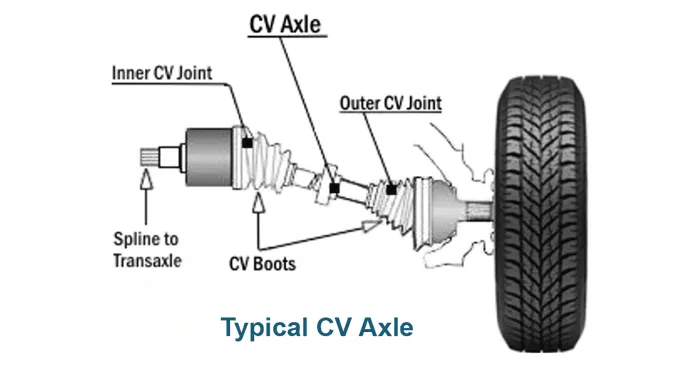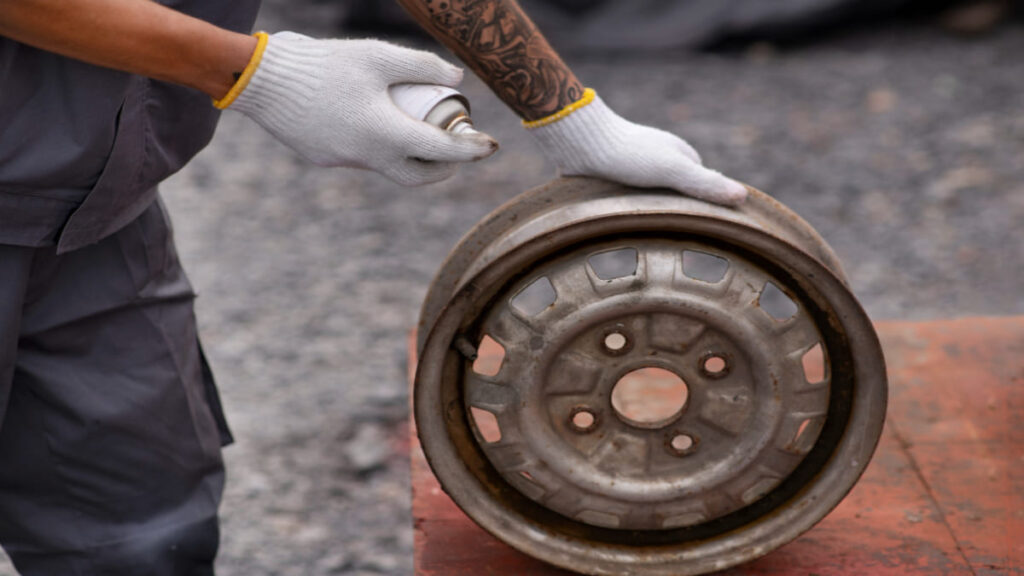Your car’s CV joint plays an essential role in ensuring your vehicle is able to provide a safe and comfortable ride. Located at the end of the axle shaft, it facilitates power transfer from the engine to the transmission while allowing flexibility due to its construction and configuration. However, when worn or damaged, you may start experiencing serious problems with your car including excessive vibration, clunking sounds, less acceleration control and even pulling configurations. In this post, you will get to know about bad CV joint symptoms that suggest if you might need inspection or replacement so that you can stay safe on the roads!
But before knowing about the different signs of a bad CV joint, let’s have a look at what a CV joint actually is.
What is a CV Joint?

A CV Joint is an important drivetrain component found in most modern cars. It allows a car’s wheels to stay connected to the transmission, even as the angle of the suspension system changes due to pressure from steering and going around corners. The universal joints used in a CV joint require constant lubrication, which is why seals and grease boots usually surround them. Without a well-functioning CV joint, your car isn’t likely to move very far.
Bad CV Joint Symptoms
Here are the important symptoms of a bad CV joint that you must not ignore to ensure your vehicle’s smooth performance. Let’s have a look:
1. Torn Boot
A torn boot on a CV joint indicates that the joint is beginning to malfunction and could potentially lead to more serious problems. A CV joint failure can cause instability in the vehicle, resulting in strong vibrations in both the steering wheel and engine. Damage to the other components of your car can occur if the issue persists for too long, as contaminants will accumulate in the unprotected weakened joint. So, don’t let a small tear turn into major repairs – address the symptom immediately!
2. Greasy Wheels

If you find grease inside your vehicle’s wheels, it is usually caused by wear and tear as the CV joint begins to fail, resulting in a buildup of dirt and dust. If left unchecked, it can cause more severe damage to your vehicle’s drive axle, leading to an expensive repair bill in the long run. Therefore, it’s important to closely monitor if you find grease inside the wheels and address any problems quickly and efficiently.
3. Knocking Sound
A bad CV joint can lead to some unpleasant symptoms, including a knocking sound. This could be a sign of serious trouble within the wheel and axle area. If the knocking sound is noticeable when turning corners or accelerating and decelerating, it’s important to have the CV joint inspected as soon as possible.
4. Bouncy Ride

Commonly referred to as a ‘hop’ sensation, a bouncy ride can occur when traveling over bumps in the road at any speed. The increased bouncing will be even more pronounced early on in your journey when the drivetrain has not had time to warm up and become loose. If you find yourself experiencing this issue while driving, getting it checked out by a qualified mechanic should be an immediate priority since a bad inner CV joint symptom can quickly deteriorate and lead to further damage.
5. Clicking or Popping Noise While Turning
One of the most recognizable signs that a car’s CV joint is going bad is a clicking or popping sound when making a turn. Whenever you take a corner, the CV joint transfers energy from the axle to the wheel, and if it’s broken or weakened it won’t be able to do its job properly. That’s when you’re likely to hear a sound like two rocks being tapped together, over and over again with each necessary turn. Ignoring this sound can put your safety at risk because it can negatively affect your car’s performance, such as sudden pulling or veering off in an unexpected direction while turning.
6. Vibration While Driving
It’s important to pay attention if you feel your car vibrating too noticeably when you accelerate or turn corners. A bad CV joint can cause an imbalance in the wheels, which causes vibration and can lead to bigger problems with the drive shaft if not fixed quickly. Don’t take chances with an uncomfortable vibration–it’s always better to get on top of potential car problems right away.
How to Diagnose Bad CV Joints in a Car?
To diagnose bad CV joints in a car, start by checking for signs of leaking grease. If the axle has been malfunctioning, usually there will be evidence of oil seeping out from around the joint. Additionally, listen and feel for clunking or knocking noises when turning or accelerating. You should also observe any unusual wear on your tires that could indicate the axle is damaged. Finally, take your car to a mechanic who can use special tools and visual inspections to determine if any damage exists in the CV joint itself.
How to Fix a Broken CV Axle?
Replacing a broken CV axle can be done at home if you have the right tools.
- First, jack up the car and remove the wheel.
- Then, disconnect the driveshaft using a ball joint separator or pickle fork to separate it from the wheel hub.
- Withdraw the CV axle while holding onto its joints and remove it from its mounting position.
- Finally, install a new CV axle into place and reconnect all of your fasteners back together.
Make sure to torque all bolts as specified by your vehicle’s manufacturer manual before driving off.
What is the Cost of CV Joint Replacement?
Depending on the age, make, and model of a vehicle, the cost of CV joint replacement varies. Replacing the CV joint costs almost double in sports or luxury cars as compared to mainstream vehicles. Instead of relying on a local expert mechanic, if you opt for a dealer, the cost hikes too.
Final thoughts
Bad CV joints are nothing to take lightly. If you start experiencing any of the symptoms mentioned above, get your car to a mechanic right away. Waiting too long can cause irreparable damage not just to your CV joint, but to other parts of your car as well. As always, prevention is key; if you keep up with regular maintenance on your car, you’ll be less likely to have to deal with a bad CV joint in the first place.
FAQ’s about Car CV:
1. Can I drive if my CV joint is bad?
Driving with a bad CV joint is not recommended. It can lead to further damage, loss of control, and compromised safety. Seek immediate repairs from a qualified mechanic.
2. Do CV joints need maintenance?
Yes, CV joints require regular inspection for wear and tear. Routine maintenance, such as checking for leaks and ensuring proper lubrication, helps extend their lifespan and prevent failures.
3. Can the CV joint be repaired?
CV joints can’t be reliably repaired. It’s often more cost-effective to replace the damaged joint. Professional inspection is crucial for accurate diagnosis and resolution.
4. How long can you drive with a bad CV joint?
Driving with a bad CV joint is risky; it may fail suddenly, causing a loss of control. It’s crucial to address the issue promptly. Avoid prolonged driving.
